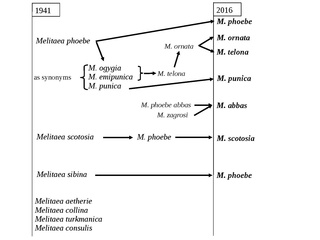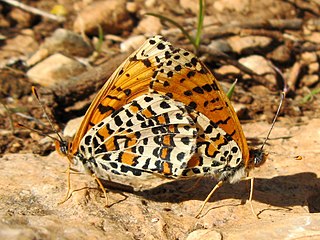
Melitaea is a genus of brush-footed butterflies. They are here placed in the tribe Melitaeini of subfamily Nymphalinae; some authors elevate this tribe to subfamily rank.

Melitaea aurelia, or Nickerl's fritillary, is a butterfly of the family Nymphalidae. It is found in central Europe.

Melitaea didyma, the spotted fritillary or red-band fritillary, is a Palearctic butterfly of the family Nymphalidae.

Melitaea phoebe, also known as the knapweed fritillary, is a butterfly of the family Nymphalidae. It is found in the Palearctic realm, except the northernmost locations. It used to include Melitaea telona, recently revalidated as a distinct cryptic species.

Melitaea parthenoides, the meadow fritillary, is a butterfly of the family Nymphalidae. Note that the common name meadow fritillary is also used for the North American species Boloria bellona.

Melitaea asteria, the little fritillary, is a butterfly in the family Nymphalidae. It is found in the Alps of Europe.

Melitaea ornata, the eastern knapweed fritillary, is a butterfly in the family Nymphalidae. The species rank of Melitaea ornata was only very recently recognised by two research groups independently. They realized that there was an unrecognised species in Europe under the name of M. phoebe. The separation of this cryptic species was based on larval morphology from the fourth instar onwards. M. phoebe larvae have a black head capsule while the larvae of this recently recognised Ponto-Mediterranean species have a brick-red head capsule. The separation of the two taxa was also supported by the results of enzyme electrophoresis study. Based on these observations, the name M. telona Fruhstorfer was taken into use for this species. In a recent molecular study, the M. phoebe group forms a monophyletic clade within the subgenus Didymaeformia. Although that study provided important results regarding the systematics of the genus, the members of the phoebe species group were poorly represented, and the need for a detailed examination of this group remained. One of the important results was the corroboration of the species rank of M. telona and the suggestion that the taxon punica may represent a separate species from both M. telona and M. phoebe. Another recent study on the morphometry of genitalia in males and females of the phoebe species group provided additional information. An analysis of a large number of specimens from the Palaearctic showed that Melitaea telona is not restricted to the Ponto-Mediterranean region since several new localities were found, including the Orenburg region (Russia), northern Iran and the easternmost border of Kazakhstan. Since the name ornata described by Hugo Theodor Christoph in 1893 is older than the name telona, the authors began to use M. ornata as the valid name for this species following the rule of priority. Recently, it has also been indicated that M. telonasensu stricto from Israel and M. ornata are different taxa. Previous morphometrical studies have already revealed small differences in the genital structures of the males but the authors interpreted the difference as a well-pronounced intra-specific difference. In contrast, molecular data clearly showed that the two taxa are genetically distinct from each other. Based on the results of the analysis of seven genes, Tóth et al. (2014) concluded that M. telona is not a subspecies of M. ornata but a species in its own right.

Chlosyne leanira, the leanira checkerspot, is a butterfly of the family Nymphalidae. It is found in North America from western Oregon south to California, Nevada, Utah and western Colorado, as well as Baja California. The wingspan is 33–40 mm. Generally, females are larger than males, but males have a more apparent red color to their wings.

Melitaea protomedia is a butterfly of the family Nymphalidae. It is found in the Amur River basin in Russia and from central and eastern China to Korea and Japan. The habitat consists of flowering meadows, forest edges and clearings.

Melitaea arcesia, the blackvein fritillary, is a butterfly of the family Nymphalidae. It is found from southern Siberia and Transbaikalia to the Amur region, Mongolia and China. The habitat consists of steppe-clad slopes.

Melitaea arduinna, or Freyer's fritillary, is a butterfly of the family Nymphalidae. It is found from south-eastern Europe across Asia Minor to central Asia and the Altai. The habitat consists of steppe-clad slopes.

Melitaea sindura is a butterfly of the family Nymphalidae. It is found in Kashmir, Chitral and Tibet.

Melitaea balbita is a butterfly of the family Nymphalidae. It is found in Pakistan and the western Himalayas.

Melitaea deserticola, the desert fritillary, is a butterfly of the family Nymphalidae. It is found in North Africa, Lebanon, Israel, Jordan, Saudi Arabia and Yemen.

Melitaea persea is a butterfly of the family Nymphalidae. It is found from Iran and Asia Minor to Afghanistan and the western parts of the Tian Shan mountains.

Melitaea solona is a butterfly of the family Nymphalidae. It is found in the Tian Shan mountains, Tibet, Alai and Trans-Alay regions.

Melitaea didymoides is a butterfly of the family Nymphalidae. It is found in Russia as well as in Mongolia and China. The habitat consists of dry meadows and xerothermic slopes with thin vegetation.
Melitaea abyssinica is a butterfly in the family Nymphalidae. It is found in Ethiopia.

Melitaea nevadensis is a species of butterfly in the family Nymphalidae.

Melitaea ambrisia is a butterfly of the family Nymphalidae. It is found in a restricted area of the mountain ranges of Central Asia. The habitat consists of flowering meadows, forest edges and clearings.

















